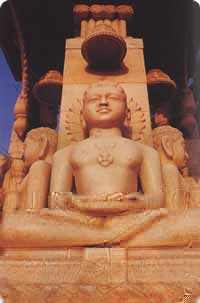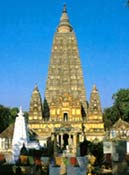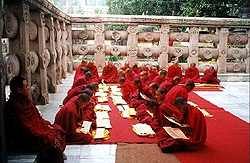|
|
BODHGAYA
The four
 most holy places associated with Buddha are Lumbini, in
Nepal, where he was born; Sarnath, near Varanasi, where he first preached
his message; Kushinagar, near Gorakhpur, where he died; and Bodhgaya,
where he attained enlightenment. For the traveller, Bodhgaya is probably
the most interesting of the four, being much more of a working Buddhist
center than an archaeological site. It’s also the most important
Buddhist pilgrimage site in the world. most holy places associated with Buddha are Lumbini, in
Nepal, where he was born; Sarnath, near Varanasi, where he first preached
his message; Kushinagar, near Gorakhpur, where he died; and Bodhgaya,
where he attained enlightenment. For the traveller, Bodhgaya is probably
the most interesting of the four, being much more of a working Buddhist
center than an archaeological site. It’s also the most important
Buddhist pilgrimage site in the world.
The focal point is the Mahabodhi Temple which
marks the spot where Buddha gained enlightenment and set out on his life
of preaching.
Buddhists from all over the world flock to Bodhgaya,
along with non-Buddhists who come to learn about Buddhism and meditation.
Bodhgaya is small and quiet, but growing rapidly and accumulating all the
usual ‘tourism’ paraphernalia. However, it is still a pleasant place
to stay a few days. The best time to visit is during winter when Tibetan
pilgrims come down from Dharamsala. The Dalai Lama often spends December
here. When the Tibetans leave in mid-February they seem to take some of
the atmosphere with them.
Mahabodhi Temple
Standing adjacent to a descendent of the original bodhi tree under
 which Buddha meditated on the excesses of life and the formulated his
philosophy of a balanced approach to it, this temple is a place of
pilgrimage for all Buddhists. which Buddha meditated on the excesses of life and the formulated his
philosophy of a balanced approach to it, this temple is a place of
pilgrimage for all Buddhists.
A sapling from the original bodhi tree was
carried to Anuradhapura in Sri Lanka by Sanghamitta (the Emperor
Ashoka’s daughter). That tree now flourishes there and, in turn, a
cutting from it was carried back to Bodhgaya when the original tree died.
A red sandstone slab under the tree is said to be the Vajrasan, or diamond
throne, on which Buddha sat.
The Mahabodhi Temple stands on the site of a temple
erected by Ashoka in the 3rd century BC. Topped by a 50m
pyramidal spire, the ornate structure houses a large gilded image of
Buddha. The current temple was restored in the 11th century,
and again in 1882. The stone railing around the temple, parts of which
still stand, is considered to be from the Sunga period (around 184-172
BC). The carved and sculptured railing has been restored, although parts
of it now stand in the museum in Calcutta and in the Victoria & Albert
Museum in London. Stone stupas, erected by visiting pilgrims, dot the
temple courtyard.
There is a great sense of peace and serenity within
the temple compound. Pilgrims and visitors from all walks of life and
religions come here to worship or just admire.
Monasteries
Most
 countries with a large Buddhist population have a temple or
monastery here, usually built in a representative architectural style.
Thus the Thai temple looks very much like the colourful wats you
see in Thailand. The Tibetan temple and monastery were built in 1934 and
contain a large prayer whee.The Burmese, who led the campaign to
restore the Mahabodhi Temple in the 19th century, built their
present monastery in 1936. The Japanese temple (Indosan Nipponji) has from
Japan – across the road is the Daijokyo Temple. There are also Chinese,
Sri Lankan, Bhutanese, Vietnamese, Nepalese, Korean, Taiwanese and
Bangladeshi monasteries. The Tai Bodhi Kham Monastery was built by
Buddhist tribes from Assam and Arunachal Pradesh. countries with a large Buddhist population have a temple or
monastery here, usually built in a representative architectural style.
Thus the Thai temple looks very much like the colourful wats you
see in Thailand. The Tibetan temple and monastery were built in 1934 and
contain a large prayer whee.The Burmese, who led the campaign to
restore the Mahabodhi Temple in the 19th century, built their
present monastery in 1936. The Japanese temple (Indosan Nipponji) has from
Japan – across the road is the Daijokyo Temple. There are also Chinese,
Sri Lankan, Bhutanese, Vietnamese, Nepalese, Korean, Taiwanese and
Bangladeshi monasteries. The Tai Bodhi Kham Monastery was built by
Buddhist tribes from Assam and Arunachal Pradesh.
Other Attractions
The archaeological museum (10am to 5pm) has a small collection of
Buddha figures and pillars found in the area. The Hindu Shankaracharaya
Math has a temple, and there’s a sculpture gallery in the grounds.
Across the river are the Dungeshwari and Suraya temples.
The 25m Great Buddha Statue in the
Japanese Kamakura style was unveiled by the Dalai Lama in 1989. There’s
a plan to build a Maitreya Buddha statue over 100m high in Bodhgaya as a
symbol of world peace.
|





